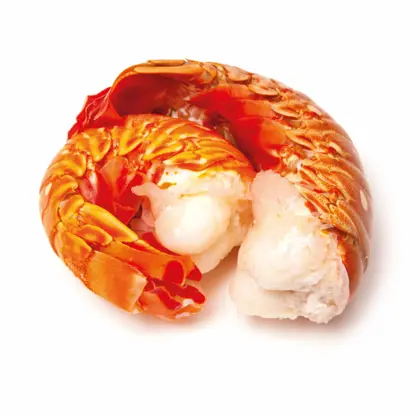Tasty Tales
The Caribbean spiny lobster is one of those foods that make me wonder, “who ever thought of eating that?” Who was the daring soul to take that leap when confronted with the spikes, antennae and spots of this creature of the deep? It must have been a brave culinary adventurer, indeed, of the same sort as those who discovered that blue cheese could taste so exquisite, or that truffles, escargot and meringue were worth ingesting… But thank heavens for them, because these are one of the most wonderful dining treats on the islands.
Claw free
Also known as the rock lobster, the Caribbean spiny lobster doesn’t have the same large claws as the Atlantic lobster that many visitors will be familiar with. These warm-water crustaceans are far more spectacular to look at and are in fact more closely related to crayfish. They can be vibrantly colored, with spots and stripes varying from light yellow to dark rust. Their shell and long, jointed antennae are covered with sharp spines and they have five pairs of walking legs. If you are interested in seeing them on a dive, you’ll have to arrange a night excursion – Caribbean spiny lobsters are strictly nocturnal.
Once the sun sets though, they emerge from their dens and will forage around the ocean floor for snails, urchins, crabs, and clams, or just about anything else they can find. These lobsters are also very social, often sharing their cave space with other lobsters and warning them of any incoming danger. But as the weather starts to turn cold, these creatures line themselves up and march single file to take shelter in less disturbed waters. They’ll rest in large crevices during the day and then recommence their long march just before sunset. This migration can take up to 20 miles from their starting point and down to depths of 30 to 100 feet. Imagine hundreds of Caribbean spiny lobsters filing quietly along to deeper water, getting ready to mate and start a whole new generation of little spiny lobsters on their way.
This predictable mass migration makes them easy prey, however, and there is a danger of overfishing from both commercial and sports fishers alike. The whole life process of the Caribbean spiny lobster is fragile, from larvae on up, and only about 1% of the eggs that are produced at a given time actually make it to adulthood. As an adult, the shell must be three inches long for the lobster to be legally caught, and that usually takes at least two years from start to finish. So make sure you are eating them during the legal catch season, from mid- February to mid-July.
From the sea to the table
But is a lobster really a lobster if it has no claws? Actually the Caribbean spiny lobster is often called langouste, so perhaps in the culinary world it’s not exactly a lobster. Don’t be disappointed, though, since these creatures make up for their lack of claws with especially tasty and distinctly sweet tail meat.
In this part of the world, the possibilities are nearly endless for such a delicacy. So imagine my delight when bad weather stranded me on a remote Caribbean island several years ago. Aft er a few days our hostess approached our table at dinner and said, very apologetically, that there was no more chicken and no more beef. Unfortunately, all we would be able to eat until the weather cleared was lobster, which had been caught just offshore. I was in heaven! Lobster in butter for lunch, lobster with pasta at dinner, lobster in tomato sauce the next day… Of course I couldn’t believe my good fortune at being served such a luxurious dish over and over. Those rainy days were without a doubt one of the highlights of my culinary experience.
Here are some tricks to preparing a lobster that have been passed down the generations in the Caribbean. Most often, the whole lobster is plunged into boiling water and presented barely split open for the diners to pluck tender morsels out and dip them in lemon butt er or a spicy sauce. The boiled tail meat can also be removed and cut into chunks for a simple salad, much like a light potato salad with minimal seasoning and homemade mayonnaise, or simmered in a sauce and placed carefully back into the tail shell for presentation. Often the tail is separated raw from the rest of the body and served on its own, either split lengthwise and then seasoned with a citrus marinade of lime juice, oil and shallots, and then cooked over an open flame, or alternately baked with a light breadcrumb coati ng. Whichever way you prepare it, you are assured a meal that is high in Omega-3 fatty acids and vitamin B12, and best of all, very tasty.
Mister Greg’s Lobster Fritter
Ingredients
1 lb freshly cooked lobster
meat
3 eggs
juice from ½ lemon
salt and pepper
vegetable oil
Serves 2 as an appetizer
Cut the lobster meat into one-inch chunks and set aside. In a shallow bowl, beat the eggs together with the lemon juice, salt and pepper to taste. Pour several tablespoons of oil into a 12-inch thick-bottomed skillet – it should cover the bott om of the pan. Heat over medium-high heat until just smoking. Quickly dip each piece of lobster in the egg mixture and place in the pan, taking care that the pieces don’t touch. Using tongs, turn each piece once the bottom is a golden brown, about one minute. Place the finished lobster pieces on a paper towel, and repeat until it’s all done. Serve immediately on a lettuce leaf with lemon wedges.
Bon Appetit!
Article written by Susan Campbell

